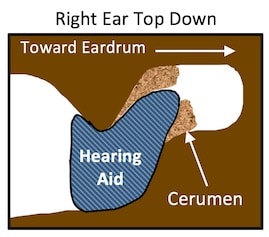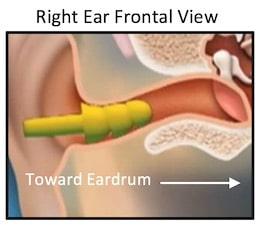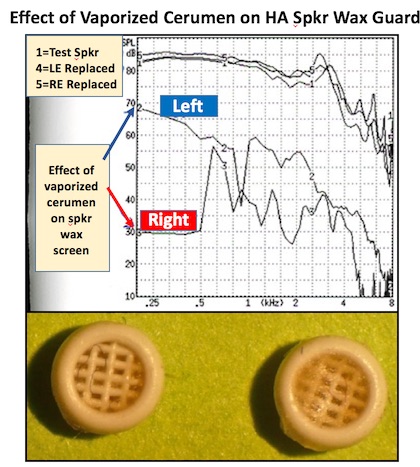Thoughts/Observations About Hearing Aids and Earwax (Cerumen)
Increased Cerumen Production
It is well known that individuals who have never worn hearing aids often show increased cerumen production when hearing aids are first worn. As a result, hearing aids and earwax are part and parcel of each other, even if that is not a preferred association.
This initial increase in cerumen production should not be surprising, especially as the ceruminous glands release their contents, acting in protective function. However, the intensity of this secretion release seems to drop off within a relatively short time after wearing hearing aids. And, this does not necessarily result in impacted cerumen.
Hearing Aid/Earmold Shape and Cerumen

Figure 1. This drawing is of the right ear, looking down on the ear canal. Many hearing aids or earmolds are carrot-shaped (tapered) at the end to facilitate insertion and user comfort. It is possible that they also push ear wax aside during insertion, and because they have little surface friction, do not allow cerumen to adhere during withdrawal. The result could easily be a buildup of cerumen around the tip of the earpiece (light brown colored area).
The shape of the ear insert (hearing aid, earmold, or other) would seem to have an effect with respect to cerumen buildup. Carrot-shaped (tapered) designs with smooth surfaces suggest that existing cerumen could be forced to the sides, and would not provide much in terms of cerumen sticking to them when withdrawn (Figure 1).
On the other hand, those inserts having a fuller and/or more deeply fitted, and especially if the tip consists of fins or an umbrella shape (Figure 2), would appear to help remove cerumen upon withdrawn1,2. This is especially true if they extend beyond the area where cerumen is produced. In such cases, the earpiece may act as a “cleaning rod” whenever it is inserted and removed, with a thin film of cerumen collecting on the sides of the ear earpiece rather than at its tip. The author’s observation is that such fitted inserts actually help keep an ear canal clean, especially if used consistently. Of course, if substantial cerumen exists upon initial insertion, it can push that more deeply into the ear canal, but that is generally a one-time event.

Figure 2. This image is of the right ear as viewed from the front. It shows a flanged earpiece in the ear canal. Most hearing aids do not use a three-flanged tip as shown on this earplug, but use a single or double flange (or what some refer to as a dome or umbrella). Such designs can also push cerumen into the ear canal, but have an added action advantage of “scraping” the ear canal during withdrawal, and thus, pulling ear wax with it. This action is enhanced the more deeply the earpiece is inserted, and especially when past the cerumen-producing area of the ear canal. With consistent use, it is speculated that cerumen would not build up in such a system.
Any new insertion of a hearing device into an ear canal, regardless of the shape or depth, is likely to extract some cerumen upon withdrawal. This is generally a wetter, or stickier type cerumen.
Cerumen Plug of Hearing Aid Sound Bore
The ear canal has two bends, and although many hearing aids/earmolds do not pass the second bend (but most preferred fits at least look into the second bend), inserting a device often results in the hearing aid/earmold sound bore coming in contact with the canal wall somewhere along the way. And, if cerumen exists in that area, there is a good chance that it will be picked up and enter the sound bore, to varying extents.

Figure 3. In-the-ear (ITE) hearing aid with sound bore plugged with earwax.
Hearing aid engineers attempt to minimize this impact by designing the sound bore openings of the devices to avoid this as much as possible, and/or to provide some kind of wax guard that can be easily replaced, even by the consumer. It has been estimated that as high as 60% of hearing aid repairs are caused by cerumen or a foreign material getting to the internal components of the hearing aid3, especially to the receiver/speaker (Figure 3).
Cerumen Vapor
Even if cerumen does not plug the sound bore, it can affect hearing aid performance. Not only can cerumen enter and close the sound bore of a hearing aid, it is even more insidious in the following way. The ear canal has a temperature gradient having its highest temperature closest to the eardrum, and its lowest temperature at the entrance of the ear canal. A hearing aid or earmold in the ear can cause heat build-up, which can cause cerumen to vaporize in the ear canal. If worn for an extended period of time (say greater than about 6 months, although this can vary), it may condense on any cooler object it encounters. And, the coolest element just happens to be the hearing aid speaker/receiver.
Figure 4 shows the results of cerumen vaporization on the wax filters of two hearing aids, along with the test results.

Figure 4. The impact of vaporized cerumen on a mesh-type hearing aid speaker wax screen (bottom). Both the left and right hearing aids were essentially non-functional as indicated by their respective response curves. Following wax guard replacement, both (curves 4 and 5 at the top) measured the same as a test speaker (curve 1 at the top).
There is always a possibility that before a hearing aid can be fitted, removal of excessive or impacted cerumen may need to occur. A following post will address this issue.
References
- Garcia H, Staab WJ. Solving challenges in deep canal fittings, Part I. The Hearing Review, Bol. 2, No. 1, 34 (1995).
- Staab w. The Philips XP peritympanic hearing aid. Seminars in Hearing, Vol. 17, No. 1, 1996.
- https://www.starkey.com/blog/2013/08/simple-at-home-hearing-aid-maintenance-
Wayne Staab, PhD, is an internationally recognized authority in hearing aids. As President of Dr. Wayne J. Staab and Associates, he is engaged in consulting, research, development, manufacturing, education, and marketing projects related to hearing. His professional career has included University teaching, hearing clinic work, hearing aid company management and sales, and extensive work with engineering in developing and bringing new technology and products to the discipline of hearing. This varied background allows him to couple manufacturing and business with the science of acoustics to bring innovative developments and insights to our discipline. Dr. Staab has authored numerous books, chapters, and articles related to hearing aids and their fitting, and is an internationally-requested presenter. He is a past President and past Executive Director of the American Auditory Society and a retired Fellow of the International Collegium of Rehabilitative Audiology.
**this piece has been updated for clarity. It originally published on May 17, 2016






